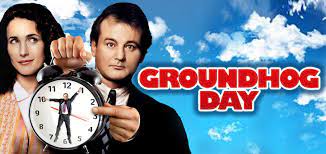I definitely knew about the basic premise of Groundhog Day before watching it. Phil Connors, a cynical, self-centered weatherman gets trapped in a time loop centered on groundhog day, where he’s forced to interact with the same small town people for an insanely long period of time. How long? The movie’s creators never give a concrete answer, and there are a multitude of different ways viewers tried to calculate it. One article I found while researching for this blogpost gave answers ranging from 6 weeks, to 10 years, to “more than one lifetime”, which is a large range for sure. Being trapped for this inordinate amount of time would drive anyone crazy, but Phil snapped especially early. On only the second loop, Phil slammed a cheerful man against the wall because he thought he was being tricked by him. While watching the movie, everybody pointed out moments when they themselves would snap (we compared it to the moment the Joker finally loses his sanity, a joker moment if you will). The times for those moments varied considerably, but were all longer than Phil’s two days. I think this “snap” is an important part in stories told using time loops, as it’s when the character finally acknowledges the bizarre situation they’re in.
While we did not look at Save the Date under a time loop lens, solely a meta one, I think that the main character of Save the Date has a similar snap when they finally tell Felicia that they’re in a video game. The “snap” in our in-class time loop was Sasha’s outburst. These are shifts from accepting the time loop as it is to trying to break it. They lead to an important shift in morality and power dynamics between characters trapped in the loop, and characters not trapped in the loop. It’s not long after his snap that Phil realizes that nothing he does has consequences, and starts doing anything he wants. He gets arrested on the third day after running from the cops, but wakes up at his bed and breakfast instead of a jail cell the next day. This lack of consequences is also something that came up in conversations regarding the movie. One friend (who shall remain unnamed to protect their identity) said “So how long until you start killing people [after realizing you’re in a time loop]?” If there are no consequences, and you see someone you absolutely despise, at what point do you just try harming or killing them. Phil straight up punched Ned the insurance salesman on the fourth day. If the movie was a bit darker it’s possible he might have gone further. Killing is an extreme example, but many of the other things Phil does fulfill a power fantasy. His repeated advances on Rita can only occur because of this power imbalance. He can predict exactly what she’s going to do or want, and adapt accordingly.
Lots of people play video games for a power trip, which is probably why the concept of a time loop works so well in video games. Video games are all about giving agency to the player, something that a time loop does perfectly. Our discussion in class solidified this link, with one point that really stuck out to me was that every game with a “GAME OVER” state does have a sort of time loop. The player can restart the game with their new, retained knowledge and try to create a better outcome. Whether an intentional mechanic of the game, like 12 minutes or Bravely Default, or just a typical restart in a platformer or puzzle game, this power trip is an important part of what makes up a time loop’s narrative structure.
cool article I referenced:
https://mashable.com/article/how-long-phil-connors-stuck-in-groundhog-day-time-loop


I really like the concept of the “snap,” and I think the snaps are pretty powerful moments in time-loop and metagames. Also for Groundhog Day, it surprised me how Phil “snapped” on like the second day. I think normally people wouldn’t snap this early and this goes to show how Phil wasn’t very ethical and didn’t really care about common courtesies to start with. I also agree with the fact that both time-loop games and video games in general give allows for power trips, however a main difference is that in non-time loop games the player is given agency and power to choose whether they want to restart the game or not, whereas in time loop games the player does not have agency to leave the loop, and they try to gain power and freedom by escaping the loop.